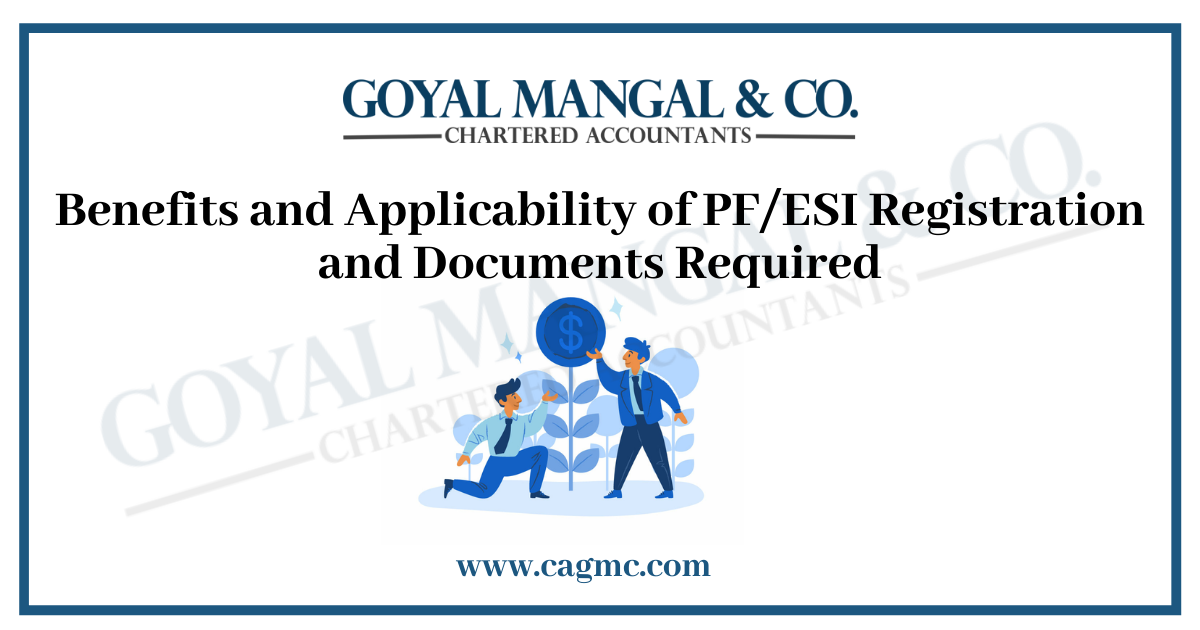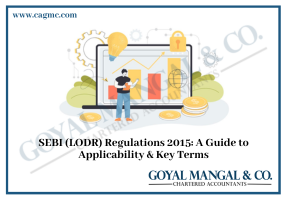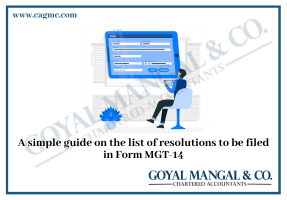
PF stands for Provident Fund. Similarly, ESI stands for Employees’ State Insurance. The government made these to ensure that the workers are financially secured while they are working and after their retirement. If you are running your own business, you should register for PF/ESI. These schemes help you secure the futures of your employees. In this article, we will learn about PF/ESI Registration- Benefits and Applicability.
Provident Fund
The Indian Government passed the Employees’ Provident Fund & Miscellaneous Provisions Act in 1952. Under this act, the Provident Fund scheme was established. Provident Fund, in general means an investment fund jointly established by both the employee and the employer to serve as long term savings. Further, its primary goal is to support your employees after their retirement. As per sec. 6 of the Act, your employee will have a part of their salaries deducted as their contribution to the fund. Simultaneously, you as the employer will have to contribute an amount as your end of the contributions to the fund. Thus, there are two part’s to the contribution to the funds,
- The employer’s contribution
- The employees’ contribution.
Once your employee registers with the Employees’ Provident Fund(EPF) scheme, they can access the services through EPF Online(EPFO) portal. It’s an online portal created to ensure that the services provided are transparent, hassle-free and efficient.
Generation of UAN
UAN stands for Universal Account Number. It was started in 2014. It is a 12-digit number. Which is allotted by the EPFO. It has helped in making access to the EPFO simpler. For a registered employee the UAN remains the same throughout their lifetime. Even if they leave your employment, the UAN doesn’t change. However, the employee ID linked to the UAN changes. Further, the new employer will have to link the new ID to the UAN. Though, the employee must activate their UAN to access the EPFO services. The employees can now generate their own UAN, through the EPFO portal.
Applicability of PF
If your company has 20 or more employees, you are required by law to register with the EPF scheme. If your company has less than 20 employees, then you are allowed to register by yourself. In other words, It’s voluntary for you. Further, it’s not compulsory for your employee to register for the EPF scheme if they have a salary of more than Rs. 15,000 per month.
Benefits of PF
PF’s currently have some of the highest interest rates at 8.10%. It provides a massive insensitive to apply for the scheme. The interest amount is accumulated in the PF account at the end of the financial year. Some of the benefits of the EPF scheme to your employees are,
- It helps in saving a large sum of money in the long run
- The amount invested is spread through the years
- It can help the employee during a financial crisis
- Helps in sustaining a decent lifestyle after retirement
- Provides tax benefits.
Employees’ State Insurance
The Indian Government passes the Employees’ State Insurance Act in 1948. It’s made with the focus, to provide social security and betterment to all workers. The scheme provides social security, in the form of financial protection in case of health-related issues. The ESI is governed by the Employee State Insurance Council (ESIC). Some of the other benefits provided by the ESIC are maternity benefits, medical benefits, disability benefits, etc. According to sec. 2(A) of the Act, you have to register your business to ESIC for the betterment of your employees. And per sec. 38 of the Act, all your employees must be insured. At least, those who meet the requirements. An employee may face many hazards while they are on the job. It’s your duty as the employer, to look after their well-being as well as their dependents. As per sec. 39, both you as the employer and your employees have to contribute to the ESIC fund at the rates specified by the government. You have to pay 3.25% of the basic wage while your employee has to pay 0.75% of the basic wage.
Applicability of ESI
As per the sec. 2(12) of the ESI Act, any organization with 10 or more employees have to register for ESI. However, their salary must not exceed Rs. 21,000 or Rs. 25,000 in case of people with disability.
Benefits of ESI
The ESIC looks to provide six main benefits for social security. These are,
- Maternity Benefits: An insured employee can get up to 26 weeks of paid leave from the time of their labour. With 100% of their wages being paid. Further, the leave can be extended for up to a month.
- Medical Benefits: An insured employee and their family can receive total medical benefits. They only have to pay a token amount of Rs. 120 annually.
- Sickness Benefits: An insured employee can get up to 70% of their daily wages during a medical leave for a maximum of 91 days in a year. Further, in the case of malignant long-term diseases, they can get up to 80% of their daily wages.
- Unemployment Allowance: If an employee has worked an insurable job for 3 years, then he is able to access this benefit. In case, of unenforceable circumstances such as the company shutting down. Further, they are able to claim an allowance equivalent to 50% of their daily wages for up to 2 years.
- Disablement Benefit: This covers both permanent and temporary disabilities that might occur to an insured employee. During, the course of their work. Due to, the hazardous nature of their work. Further, they can get up to 90% of their daily wages. Moreover, in case of death, their immediate family can get the benefits.
- Extended Benefits: Some of the other benefits covered by the ESI are Funeral Expenses, Old Age Medical Care, Rehabilitation, etc.
Documents Required
The documents required to apply for both the ESI and PF are similar. They are:
- Copy of PAN/Aadhaar Card
- A copy of the Certificate of Incorporation/Registration Certificate
- Copy of Bank Statement
- Copy of Electricity Bill (address proof)
- A cancelled cheque
- List of all employees
- Copy of Rent/Lease agreement
- Digital Signature
- GST number
Other than this for EPF registration, you’ll require,
- Employee wise breakup of contributions
- UAN
And, for ESI registration you’ll require
- Employee Insurance Number
- Date of Appointment
- Employees’ Personal Details (Name, Parent’s Name, etc.)
- Bank Account Details
- Employer Code no.
- Employer Insurance No.
- Contact Information
Conclusion
It’s your responsibility as the employer to provide security to your employees. It is legally required for you to register for the government schemes. These schemes were established to serve and protect those who are in the most need. Further, these schemes are made with the idea of helping the people most in need. In conclusion, it’s your duty as the employer to register your business and your employees to EPF/ESI.







